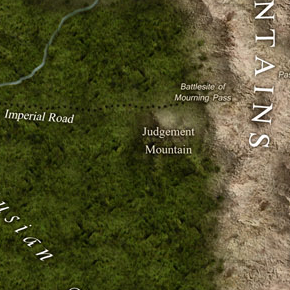Difference between revisions of "Judgement Mountain"
| (8 intermediate revisions by one other user not shown) | |||
| Line 1: | Line 1: | ||
{{Village_infobox | |||
|image=https://wiki.achaea.com/mediawiki/images/2/2d/Judgementmountain-map.png | |||
|villagename=Judgement Mountain | |||
|leader=Grandmaster [[Kevadrin]] | |||
|discoverer=Iocun | |||
|allies= | |||
|patron= | |||
|enemies=The [[Migri]]}} | |||
'''Judgement Mountain''' was the original home of the [[Sentaari]]. When their weapons were confiscated during the [[Wars of Succession]], it was at this location that the art of [[Tekura]] was developed as a means to defend themselves unarmed. In the caves at the base of the mountain live the [[Migri]], a race of subterranean [[hobgoblins]] hostile to the [[monk|monks]] which train nearby. | |||
==History== | |||
Centuries ago the Sentaari monks of Judgement Mountain were unsurpassed as a centre of training in the arts of Tekura. After the fall of the [[Seleucarian Empire]] the order was nearly extinguished in the ensuing terrors which decimated the population. A single monk survived the disasters, returning to the ruins to rebuild the monastery. The new generation of martial artists laid the name of 'Sentaari' to rest, preferring to refer to themselves simply as the monks of Judgement Mountain. | |||
==Geography== | |||
The monastery is perched atop the peak of Judgement Mountain which looms above the dense canopy of the southern [[Atrousian Jungle]]. Half of the edifice is built into the limestone of the mountain itself while the rest is meticulously constructed of wood. A mountain spring at the foot of the mountain provides fresh water to the inhabitants, while a nearby steep, zig-zagging path leads from the base of the boulder-clad cliffs to the summit. | |||
==Inhabitants== | |||
*Grandmaster [[Kevadrin]] | |||
*[[Qiland]] | |||
*[[Davkas]] | |||
*[[Marna]] | |||
*[[Ciglo]], the historian | |||
==Culture== | |||
The inhabitants of Judgement Mountain are all trained monks or initiates in training. They live peaceful lives devoted to continuing the study of Tekura under a philosophy of four principles: humility, strength, courage, and honour. While they have abandoned the old references, they maintain their traditions, finding wisdom and serenity in the simple elements of life. | |||
[[Category: Villages]] | |||
[[Category:Mountains]] | [[Category:Mountains]] | ||
Latest revision as of 03:58, 13 September 2019
 |
|
| Judgement Mountain | |
| Leader | Grandmaster Kevadrin |
| Discoverer | Iocun |
| Enemies | The Migri |
Judgement Mountain was the original home of the Sentaari. When their weapons were confiscated during the Wars of Succession, it was at this location that the art of Tekura was developed as a means to defend themselves unarmed. In the caves at the base of the mountain live the Migri, a race of subterranean hobgoblins hostile to the monks which train nearby.
History
Centuries ago the Sentaari monks of Judgement Mountain were unsurpassed as a centre of training in the arts of Tekura. After the fall of the Seleucarian Empire the order was nearly extinguished in the ensuing terrors which decimated the population. A single monk survived the disasters, returning to the ruins to rebuild the monastery. The new generation of martial artists laid the name of 'Sentaari' to rest, preferring to refer to themselves simply as the monks of Judgement Mountain.
Geography
The monastery is perched atop the peak of Judgement Mountain which looms above the dense canopy of the southern Atrousian Jungle. Half of the edifice is built into the limestone of the mountain itself while the rest is meticulously constructed of wood. A mountain spring at the foot of the mountain provides fresh water to the inhabitants, while a nearby steep, zig-zagging path leads from the base of the boulder-clad cliffs to the summit.
Inhabitants
Culture
The inhabitants of Judgement Mountain are all trained monks or initiates in training. They live peaceful lives devoted to continuing the study of Tekura under a philosophy of four principles: humility, strength, courage, and honour. While they have abandoned the old references, they maintain their traditions, finding wisdom and serenity in the simple elements of life.